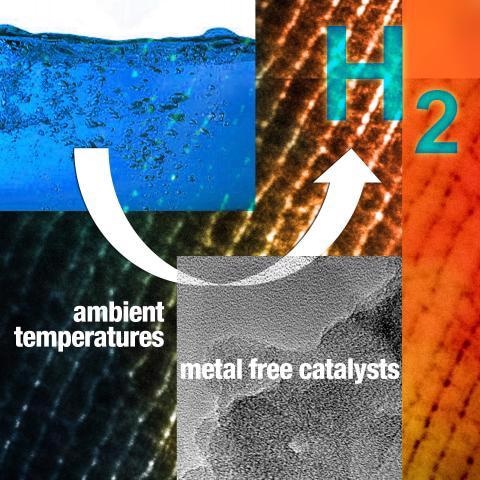A new catalyst from the US Department of Energy’s Ames Laboratory and collaborators draws hydrogen from hydrogen storage materials in a simple and efficient manner.
 A nitrogen assembly catalyzes the cleavage of carbon-hydrogen (C‒H) bonds in LOHCs and facilitates the desorption of hydrogen molecules. Image Credit: AMES Laboratory
A nitrogen assembly catalyzes the cleavage of carbon-hydrogen (C‒H) bonds in LOHCs and facilitates the desorption of hydrogen molecules. Image Credit: AMES Laboratory
The process takes place at mild temperatures and under normal atmospheric conditions, without making use of metals or additives. The discovery provides a promising new solution that addresses a persistent difficulty in using hydrogen fuel for transportation and other applications.
Hydrogen fuel is one possible solution in the effort to reduce reliance on fossil fuels.
As per the DOE, enhancing hydrogen storage is crucial in advancing hydrogen fuel cell technologies. At Ames Laboratory, researchers Long Qi and Wenyu Huang researched the extraction of hydrogen from a class of materials known as liquid organic hydrogen carriers or LOHCs.
One of the approaches to store hydrogen is chemically. Chemical storage depends on materials that act with hydrogen molecules and store them as hydrogen atoms, like in LOHCs. This kind of storage enables large amounts of hydrogen to be kept in small volumes at ambient temperatures. But for the hydrogen to be beneficial, catalysts are required to trigger LOHCs and discharge the hydrogen. This process is known as dehydrogenation.
Qi described that presently there are other dehydrogenation techniques, but they have their downsides. Some techniques depend on metal-based catalysts, which involve crucial platinum group metals.
Supplies of these metals are restricted and expensive. Other techniques need additives to discharge the hydrogen. The additives cannot be used again and lead to a greater overall cost since they need to be added in every cycle.
The newly developed catalyst by Qi and Huang does not need additives or metals.
It’s fairly simple. Basically, just add the metal-free catalyst into the LOHC, and then the hydrogen gas is just popping out, even at room temperature.
Long Qi, Scientist, AMES Laboratory
The catalyst is made of carbon and nitrogen. The key to its productivity is the structure of the nitrogen. Catalytic activity can occur at room temperature due to the unique closely spaced graphitic nitrogens as nitrogen assembly, which was formed during the carbonization process.
The cleavage of carbon-hydrogen (C‒H) bonds in LOHCs has been catalyzed by the nitrogen assembly and streamlines the desorption of hydrogen molecules. This process is what makes the catalyst highly efficient compared to other catalysts that are in use.
Qi and Huang described that depending on DOE goals for vehicle technologies; the hydrogen storage capacity needs to be close to 6.5% by weight. They are optimistic regarding the future of their study to fulfill the goal with molecules that have a greater capacity.
This research will positively impact the target of reducing carbon dioxide emission and we will need to develop more efficient catalytic systems.
Wenyu Huang, AMES Laboratory
In 2019, the transportation industry accounted for 29% of the overall carbon dioxide emissions in the U.S. Qi said that the ease and efficiency of this process could benefit the transportation industry in the future.
The benefits come from a combination of using LOHCs and a catalyst like this one. The combination can extract usable hydrogen from storage at a lower cost and under milder conditions than current technologies. A greater hydrogen density can provide a greater charge for hydrogen fuel cells, which could provide power to vehicles over greater distances.
Both Qi and Huang emphasized that this research is an important step to support the national mission to become carbon-neutral by 2050 by providing an easy and efficient way to dehydrogenate LOHCs.
This research is further discussed in the paper “Metal-free carbocatalyst for room temperature acceptorless dehydrogenation of N-heterocycles,” authored by Haitao Hu, Yunqing Nie, Yuewen Tao, Wenyu Huang, Long Qi, and Durga Renfeng Nie; and published in Science Advances.
Ames Laboratory is supported by the Office of Science of the U.S. Department of Energy. The Office of Science is the single largest supporter of basic research in the physical sciences in the United States and is working to address some of the most pressing challenges of our time.
Journal Reference:
Hu, H., et al. (2022) Metal-free carbocatalyst for room temperature acceptorless dehydrogenation of N-heterocycles. Science Advances. doi.org/10.1126/sciadv.abl9478